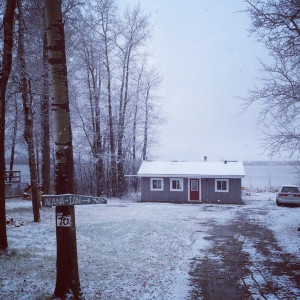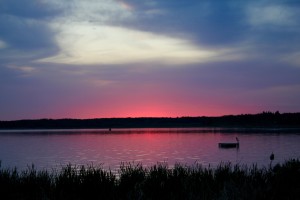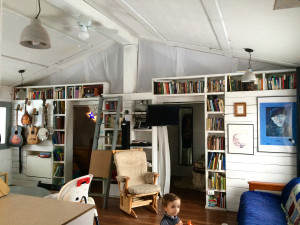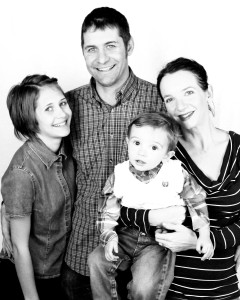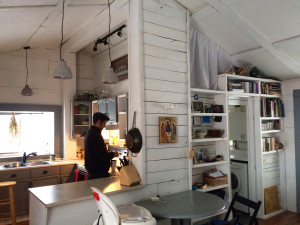Alana Levandoski is a singer, songwriter, and author who discovered that life as a busy and successful professional recording artist left her unhappy and unfulfilled. She toured around the world with musicians such as Bruce Cockburn, Blue Rodeo and Tanya Tucker and made a number of acclaimed albums, but then left that world behind. Now happily married, mother of a young son with another baby on the way, Alana and her husband have taken up a “new monastic way” of living in a small house on the edge of a lake in rural Alberta, where she continues to make beautiful music. We interviewed her from her studio, an old shed lovingly renovated.
Kolbe Times: First, tell us about your relatively newfound love of simplicity – after rather chaotic years of touring and making music with so many people.
Alana: In my former life, I was essentially a workaholic. My self worth and value lay in working all the time – and also in being “ever the entertainer”; always the life of the party. It started to take its toll. When the underbelly of something is chaotic and confused, it’s going to show up eventually in the light, so to speak. My professional and personal life fell apart almost completely at one point. In a strange way, it gave me the license to release this workaholic identity that I was building. I remember standing on the edge of Lake Winnipeg, looking at the moon, when this uncanny intuition arose that my worth could not be taken, no matter what. It was built into the very fabric of my being. That was the epiphany moment, and then the healing could begin. I asked my Anglican priest for something to read to help me “fix” things, and he told me to go read the mystics. So I began to read Teresa of Avila, Thérèse of Lisieux, Julian of Norwich, Hildegard of Bingen, John of the Cross and they became almost like intimate friends.
Embracing simplicity evolved in my life in a very natural way – not a reactionary way. It’s helped me become at peace with the past and at peace with the present, and I’m working towards becoming at peace with whatever the future will bring. It’s about trying to live consciously, be awake, be present as a parent, and try to pay attention to the promptings that come at a creative level. I heard somewhere that “complexity kills” – and I think in a sense that’s very true. Being able to simplify makes me a better artist.
Kolbe Times: What was it like to live with the Benedictines for six months, and how did that come about?
Alana: Around 2010, after I had lost a whole lot – I was doing whatever I could to ‘buy some time’ while I was in therapy. In exchange for living there, I renovated a little living space at All Saints Anglican Church, downtown Winnipeg, and would walk through the place at night to check on it. I needed sanctuary, because I felt on the edge of despair. My community there, called St. Benedict’s Table, was connected with St. Benedict’s Monastery and Retreat Centre, so I started volunteering at the Monastery, helping with their big garden on Saturdays. Eventually I volunteered to live there and work four hours a day, while also participating in community life with the Benedictine sisters – chanting the Psalms in the daily office, and taking part in the times of silence at breakfast. It was a very beautiful introduction to monastic life. I also had access to the sisters’ personal library, and so even though there was a lot of pain in my body and in my heart at that time, it was also very dreamy. I was becoming a mystical nerd – so excited that my room was right next to the library!
Kolbe Times: And I guess this experience led you to start you thinking about the possibility of living with a Sacred Schedule of your own.
Alana: Yes. Much later I came across Cynthia Bourgeault’s book Chanting the Psalms. She gives a history of the practice, but also discusses how you can participate in it today in your own life. It comes with a CD, and she teaches different styles of chants, and also shows how you can play around with them. Another book that was important to me in this whole process was Sister Joan Chittister’s book The Monastery of the Heart, which lays out ideas for fitting a monastic way of living into everyday life.
Kolbe Times: Fast-forward a few years – when you and your new husband built a “tiny house” on a friend’s property. Tell us a bit about that experience.
Alana: Well, just to give you an idea of what it looked like, the main floor of our first tiny house was 160 sq. ft. The lofts were 80 sq. ft. with a cathedral ceiling that hung over the deck. There was no plumbing, so I remember it was like a little pilgrimage to walk to the shower and bathroom that we had access to. We had electricity, so we had a Coleman stove and a toaster oven. We lived there for two years. We had to feed the fire two or three times during the night during the winters. Leading up to the labour, we spent two weeks at my spiritual director’s house, and then we house-sat for a bit after Oliver was born. Then we all moved back into the tiny house and started to look for our own property. Eventually we found a ramshackle old 600 sq. ft. cabin on the edge of a lake, and basically rebuilt it from the ground up. We moved in just a month before Oliver’s first birthday. Ian then spent a summer turning our old shed into a studio with a lean-to addition. So now we have “a place to stand” – which a friend recently called our family hermitage.
I think that from the experience of living in that first tiny house, we know the bare minimum of what we desire to have, and above and beyond that we don’t really care. That feels really freeing. We’ve chosen to live in this simple, modest way, and we feel that we are living in solidarity with all the people who live in similar circumstances, not necessarily of their own choosing.
Kolbe Times: So how is living a Sacred Schedule developing, and what does it look like for you and your family?
Alana: I operate on a 3-hour workday in the mornings and my husband Ian operates on a 4-hour workday in the afternoons. I like to say that we co-work a full time job! We use our studio as seriously as we would an actual job site, but the day operates on somewhat of a monastic schedule inspired by my time living with the Benedictines. We chant the Psalms in the morning, read aloud to each other from a book of prayers at mealtimes, and at other times of the day we do 15-minute centering prayer sessions. We also go for daily walks, which are a huge contemplative benefit to me because I’m a high metabolism, creative freak!
We use a regular calendar but were also recently given a liturgical calendar that operates on the Christian narrative instead of the months. It’s a reminder to us that we choose to live outside of the dominant narrative of this culture. And the other part that makes our days sacred is that we try to see the whole of what we do, whether interacting with Oliver, writing an email or doing laundry, as incarnate, holy activity.
It’s definitely a freeing schedule – not a binding schedule. You wake up in the morning and you are excited to be alive. You look forward to the day ahead, knowing that your day is intentional.
What makes a family monastic schedule different from a traditional monastic schedule, of course, is that life sometimes causes you to make adjustments in certain ways, and that’s okay. So, for instance, sometimes work projects cause us to amend our schedule. But that way it’s possible to blend a sacred schedule into your life.
Kolbe Times: Do you have advice for someone wanting to explore this “new monastic way” but feels stuck in a busy life?
Alana: Firstly, if you start imagining what it might look like for yourself, it will look different than it will look like here, for us. My advice is to make it your own. We made some pretty big decisions last year around my husband’s employment that allowed me to make my latest album Behold, I Make All Things New. It would have been impossible to make it without those decisions. But I recognize not everyone is in the position to take the risks that we’re taking. So I would suggest starting to imagine what your own life could look like, and then gather material that has wisdom to it. Joan Chittister is an incredible resource on this subject. Even though she’s a monastic herself, she writes for the everyman and everywoman. There’s also an author named Thomas Kelly from the Quaker tradition that I love. I’m very inspired by the Quakers – they have a lot of wisdom around the contemplative life and simplicity. I also love Parker Palmer, and his book Let Your Life Speak, which is about a Quaker vocational process that discerns gifts. It’s really helpful for anyone who is in chains and agony around their life’s work. It’s a book that gave me a lot of peace – I read it after my big “descent” when I had a lot of points of deep stress and instability in my psyche that were coming from a crazy life in the music business. It helped me look at my life and ask what it was saying to me. So spending some time discerning and examining the things in your life that are giving you push-back is helpful and important.
Kolbe Times: What’s your next project?
Alana: My next project is with contemplative author and trauma therapist James Finley, who has been really inspirational. He was one of my core faculty teachers at the Living School, Centre for Action and Contemplation in New Mexico. We’re making an album called Sanctuary: Exploring the Healing Path with Alana Levandoski and James Finley. It’s includes a series of chants that I’m composing, with spoken word by James Finley – and it’s going to include a children’s choir as well, which represents the voice of the inner child. I hope the album will inspire people to re-parent their inner child, if that needs re-visiting. I’ve been singing some of the chants to Oliver at bedtime – he’s my testing place.
The words in one of the chants in the album are “If you know what your raw and beautiful heart is made of, you can go into the hurting places.” I think that’s where the starting point is. If you know what your heart is made of, you can start to intuit what everything else is made of, and how sacred everything is. The ordinary doesn’t go away, in fact, the ordinary is incarnate. We’ve unfortunately relegated incarnation into the high places, which is not the example of Jesus at all. This new project on healing is proving to be just as incarnate to me as the Christ narrative contained in my album Behold, I Make all Things New.
www.facebook.com/alanalevandoski
Follow Alana on twitter @alanalevandoski
Check out Alana’s new video below.


